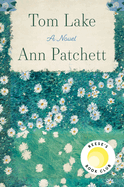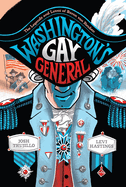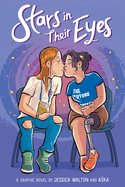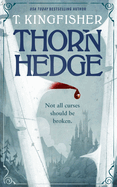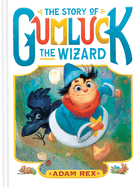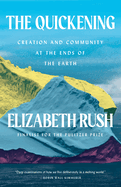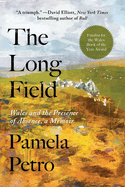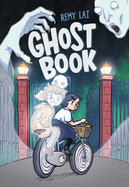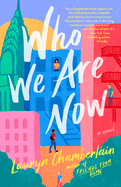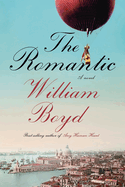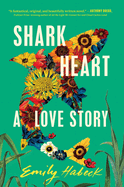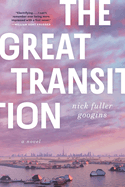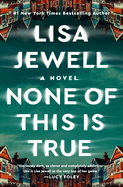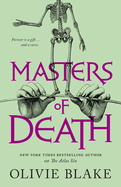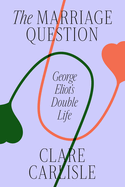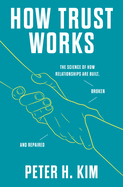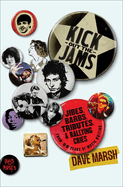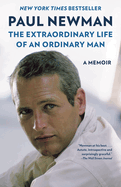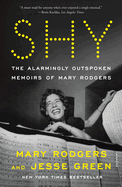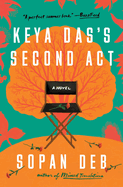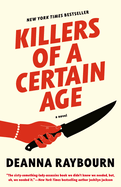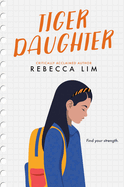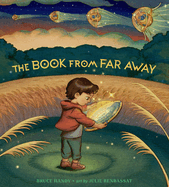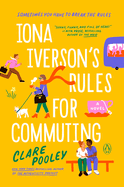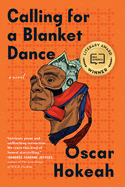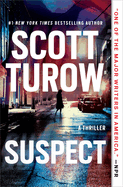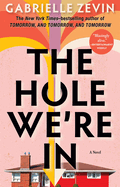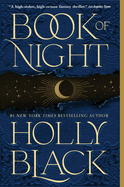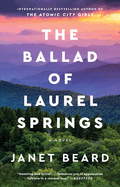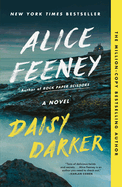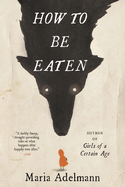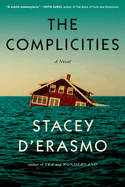Friday, August 18, 2023
We review some outstanding nonfiction this week, including the graphic-format biography Washington's Gay General by Josh Trujillo, illustrated by Levi Hastings, "a dazzling reexamination" of U.S. independence, and Pamela Petro's "enchanting memoir" The Long Field, "so multifaceted that it resists easy categorization." And don't forget Mary Rodgers's Shy and Paul Newman's The Extraordinary Life of an Ordinary Man, both now in paperback, perfect for toting to the park or beach. Plus, the "delightful, sweet graphic novel" Stars in Their Eyes by Jessica Walton, illus. by Aśka, a whirlwind queer YA romance set at a fan convention. And so many more!
Elizabeth Rush talks in The Writer's Life about her experience aboard a scientists' ship bound for Antarctica, chronicled in The Quickening (also reviewed in this issue).
Tom Lake
by Ann Patchett
Ann Patchett (These Precious Days; The Dutch House), once again displaying her singular talent as an author, peels back the layers of a story of coming-of-age, love, life, and expectations in Tom Lake. It is 2020, and the Covid-19 lockdowns have brought Lara's three grown daughters home to the cherry farm where they were raised. She regales the trio, standing in for the seasonal workers unable to come due to travel restrictions, with the story of her long-ago romance with Peter Duke, years before he became a world-famous movie star, and she became the contented wife of a cherry farmer. "It isn't a funny story except for the parts that are," she tells them. This captures the heart--and the art--of Tom Lake, which is not necessarily funny, except when it is, and is fully reflective of the nuance and complexity of this thing we call life. Within the retelling of her past and might-have-been life as an actress, Lara's story evolves to become about much more than a one-time summer fling: it is the story of her growth as a person, woman, wife, mother, and her as a product of every decision she's made along the way and every decision made for her.
In many ways, Patchett's stunning novel is a story of opportunity missed or not taken; her daughters' unspoken questions hang between them: "Are you sorry? Don't you wish?" Tom Lake, though, is not a novel of regret but rather one of clarity, offering a tale of gratitude borne of perspective and experience, a life lived in the present--even as it is shaped by the past. --Kerry McHugh, freelance writer
Discover: From the author of The Dutch House comes a stunning and layered novel of a long-ago romance and the twisty paths of love and life, told by a woman to her daughters during the early days of Covid-19.
Who We Are Now
by Lauryn Chamberlain
Lauryn Chamberlain (Friends from Home) captures the essence of ever-changing friendships through the striking narrations of Rachel, Clarissa, Dev, and Nate in Who We Are Now. Over a 15-year period, the college friends question their individual paths, identities, and importance to each other following the seemingly unbreakable bond they built during their years at Northwestern University. After surviving their "ramshackle" college house; their joint record of 10 rounds of the "shot ski without anyone throwing up"; and actual graduation, Nate toasts: "To the best four years, and my three best friends," adding, "If that's cheesy, fuck it." The novel begins at the end of their college careers, and the four friends can't imagine navigating their uncertain futures without each other. However, faced with the professional and personal setbacks of early adulthood, they find that feelings of anxiety, jealousy, and disconnection begin to crack the foundation of their friendship.
Chamberlain successfully packs small moments with tremendous meaning. The point of view seamlessly alternates among the four friends, covering each year following their college graduation, with each character communicating individual emotions and insights into their choices, failures, and successes. Expertly intertwining important conversations about race, sexuality, sexual violence, and addiction, Chamberlain conveys the familiar struggles of those in their 20s and 30s. Who We Are Now allows readers to follow the small and big decisions that have the power to change everything in an instant. Down-to-earth and raw prose make Rachel, Clarissa, Dev, and Nate an inspirational example of evolving love, loss, and what it really means to be a friend. --Clara Newton, freelance reviewer
Discover: Lauryn Chamberlain delivers raw emotion and insight into young adulthood and friendship in this inspirational portrayal of the evolution of wants, needs, and relationships.
The Romantic
by William Boyd
Readers for whom no literary thrill is greater than a spirited, multidecade saga about an eventful life will love The Romantic, a historical novel by William Boyd (Waiting for Sunrise). In an author's note, a certain W.B. claims to possess the "unfinished, disordered, somewhat baffling autobiography of Cashel Greville Ross," who was born in 1799, along with Ross's letters and other items, "a fragmentary history of the time he had spent on this small planet." What follows is a boisterous, entertainingly episodic trip through Ross's peripatetic life, starting with his years as an orphan in Ireland on the estate of Sir Guy Stillwell and being raised by Aunt Elspeth, the governess who cares for Sir Guy's teenage daughters.
Except that's not quite accurate, and that's part of the fun of The Romantic: events aren't always as they appear. This novel is jam-packed with events, with Ross ricocheting like a pinball through the 19th century from one memorable encounter to the next: tutelage at an Oxford academy where a Bible is a required school supply; combat at the Battle of Waterloo; a postwar spell hanging out with Percy Shelley and Lord Byron in Italy, where he has an affair with Mary Shelley's sister; and, most enduringly, his romance with Contessa Raphaella Rezzo, who may or may not be the love of Ross's life. The Romantic may be overstuffed with incident, but the incidents are never dull. Romantics are trusting souls, sometimes to their detriment, as Boyd makes clear in this enjoyable adventure. --Michael Magras, freelance book reviewer
Discover: William Boyd charmingly chronicles the 19th-century life of Cashel Ross, whose travels take him from an Irish childhood to the Battle of Waterloo to affairs with a succession of women.
Shark Heart
by Emily Habeck
A woman's life and marriage are upended when her husband undergoes a Kafkaesque transformation in Emily Habeck's strikingly poetic, deeply moving first novel, Shark Heart. Newlyweds Wren and Lewis expect to have a long, happy marriage until Lewis notices his nose has grown spongy. The doctor diagnoses him with a Carcharodon carcharias mutation, a condition that will cause Lewis to transform into a great white shark and require relocation to the ocean. Practical, no-nonsense Wren reacts by commenting that the first year of a marriage is the hardest, "a bypassing of the truth, because there would not be another year to measure against this first one." Lewis, a striving actor turned drama teacher who longs to live in a treehouse, loses his human body and job and becomes increasingly belligerent. Wren, who spent her childhood and young adulthood as her mother's caretaker, cobbles together a saltwater pool and teaches herself scuba diving. Lewis's continually progressing condition will push their marriage to the breaking point, and leave them both struggling to find safe harbor in the face of an unimaginable future.
Habeck's world contentedly defies science and logic. Humans mutate into animals. A side character is pregnant with falcons. This slightly askew setting makes the characters' physical challenges feel more distant, allowing readers the space to fully engage with elements of loss and mortality. Told in a mixture of formats, including prose, poetry, and theatrical scripts, Shark Heart is a profound, lovely, hopeful interrogation of love and humanity. --Jaclyn Fulwood, blogger at Infinite Reads
Discover: A man's transformation into a great white shark upends his and his wife's lives in this strange, profound, and lovely novel.
The Great Transition
by Nick Fuller Googins
In The Great Transition, his first novel, Nick Fuller Googins delivers the equivalent of a Michael Bay film, filled with pulse-pounding scenes as well as tearjerker moments. But instead of giant robots, Googins's stakes are the climate crisis, a family as it disintegrates, and a not-so-simple question: What happens after you save the world? It has been 16 years since the Great Transition, the greatest movement in the history of humankind to staunch the end of the world. Humanity has brought the world's carbon emissions to zero, effectively saving the planet. The story revolves around a family--Larch, a hero of the movement who has enjoyed the pleasures of success, and his daughter, Emi, too young to know the true pain of near collapse. ("There was poverty and pandemics and like a thousand people owned everything on the planet. But nobody had any idea what was coming. Not really. It's hard to imagine what it must have felt like. I try.") When Kristina (Larch's wife and Emi's mother) becomes a suspect in the assassination of climate criminals and disappears, it throws their lives into turmoil as they travel to a hurricane-ravaged New York City to find her.
Googins's choices around perspective and time create a visceral reading experience: readers feel the heat as Larch jumps into the fires along the West Coast of the United States and experience the pain as Emi talks about the many ways to "ignite" her mother. Googins has done something brilliant and beautiful in this tender novel, massive in its scope. --Dominic Charles Howarth, book manager, Book + Bottle
Discover: The Great Transition explores the climate crises in a perfect blend of summer blockbuster grandeur and tender family drama.
Mystery & Thriller
None of This Is True
by Lisa Jewell
The coincidental meeting between two strangers, each celebrating her 45th birthday, progresses into a decidedly creepy relationship in the engrossing and entertaining None of This Is True by Lisa Jewell (The Family Remains; Invisible Girl; The Family Upstairs).
This edgy novel, Jewell's 21st, raises the standard for psychological thrillers, with realistic characters who have indecipherable motives that enhance its wonderfully off-kilter plot. Effervescent, glamorous Alix Summer instantly mesmerizes docile, drab Josie Fair; each is celebrating her birthday in the same North London pub. Alix, Josie's "birthday twin," appears to have what Josie wants--a successful career as a podcaster, a nice husband, two beautiful children, friends. Josie's solitary life includes a husband 27 years older than she is, two estranged adult daughters, no friends, and a part-time job as a seamstress. Josie insinuates herself into Alix's life, arranging chance meetings and eventually suggesting the story of a regular woman, such as herself, changing her life as the perfect podcast fodder--instead of the successful females usually featured. Josie's stories are hardly ordinary, with tales of pedophilia, child abuse, domestic violence, and murder. In her frequent, often unplanned, visits to Alix's home to record the podcast, Josie becomes overly intrusive in Alix's life and marriage, repeatedly making note of Alix's husband's alcoholic binges. Alix begins to wonder if Josie's lurid stories are true, as her new friend becomes more unhinged and controlling.
Jewell's affinity for devious characters soars in None of This Is True. She explores the darkness that creeps into ordinary homes, leading to a shattering, deliciously pitch-black finale. --Oline H. Cogdill, freelance reviewer
Discover: In this edgy thriller, a stranger with lurid personal stories insinuates herself into the life and work of a popular podcaster.
Science Fiction & Fantasy
Thornhedge
by T. Kingfisher
A toad fairy shares the real story of "The Sleeping Beauty" in Thornhedge, a clever adult fairy tale that could only come from T. Kingfisher (A House with Good Bones; Nettle & Bone; The Hollow Places). Toadling has been alone for a very long time, keeping vigil by the tower in which a maiden lies in an unending magical sleep. Decades and countless people pass by, and Toadling remains, dreaming of the day people will finally forget the story they know--the wrong one. Toadling's years slip by until Halim, a Muslim knight from afar, arrives: "I have come because of a story," he says. "I read it in a book. Several books." The endearing toad heroine reveals the dark truth, told partly in flashbacks, about the sleeping princess and why she must never be awakened. Will Halim believe her? Or is he like all the other would-be rescuers, swayed by a pretty face and a story?
Kingfisher's talent for crafting original fairy tales and reimagining others is in full effect here. Whether it's Beauty and her Beast fighting thorny blooms in the gothic Bryony and Roses or a punny Hamster Princess saving the day (Hamster Princess: Harriet the Invincible, writing as Ursula Vernon), Kingfisher's characters and wit drive her books. Even with some more sinister elements, Thornhedge has all the gentle humor and big-hearted characterization the author's fans have come to expect. It is not a rollicking tale of sword and sorcery but a quieter, wryly funny, and boundlessly loving story of a toad and the knight who inspires her to finally make her own happy ending. Those who enjoyed The Undertaking of Hart and Mercy and A Spindle Splintered will adore this. --Suzanne Krohn, librarian and freelance reviewer
Discover: Inspired by a traveling knight, a gentle toad fairy corrects a false story and a real curse in T. Kingfisher's masterful, wickedly clever reimagining of "Sleeping Beauty."
Masters of Death
by Olivie Blake
In Masters of Death, a wildly inventive contemporary fantasy from Olivie Blake (One for My Enemy), an eclectic, morally questionable cast of paranormal beings joins forces to free Death personified. The story opens as aswang realtor Viola--a shapeshifting cat-vampire from Filipino folklore--attempts to sell a house haunted by its recently deceased owner. Soon she seeks out Fox, the godson of Death, a charlatan medium and "mortal with an abandonment complex," given that gambling addict Death has disappeared, caught up in his own game by a demon king's world-ending machinations.
This is the kind of humor Blake employs to great effect: humanizing her ridiculous characters with the kind of flaws they believe themselves immune from as immortal beings. Isis summarizes this ragtag crew: Louisa's a siren; Sly is fae; Brandt's "a random thief we don't really know anything about yet, short of his romantic falling-out with Fox"; Mayra's "a guardian angel who's almost certainly hiding something"; Cal is a "reaper who's very clearly obsessed with Mayra"; and Tom is a "poltergeist who won't be quiet." They'll have to work together to win the game and avert disaster, but how can they, with an enemy who so expertly exploits their weaknesses? Funny, romantic and unexpectedly poignant, Masters of Death is perfect for fans of Terry Pratchett's Mort, Christopher Moore's A Dirty Job, and TJ Klune's The House in the Cerulean Sea. Anyone who craved an Aziraphale-Crowley romance in Good Omens should immediately pick this up. --Suzanne Krohn, librarian and freelance reviewer
Discover: This wickedly clever paranormal contemporary fantasy novel is a sure winner for fans of Good Omens; Mort;and The House in the Cerulean Sea.
Graphic Books
Washington's Gay General: The Legends and Loves of Baron von Steuben
by Josh Trujillo, illus. by Levi Hastings
American independence gains a dazzling reexamination with Washington's Gay General: The Legends and Loves of Baron von Steuben, an inquisitive graphic novel written by Josh Trujillo and illustrated by Levi Hastings (Be Gay, Do Comics). The Steuben name is stamped on several regions around the U.S. to commemorate the valor of a Prussian general whose contributions to the American military helped win the Revolutionary War. But much like the Marquis de Lafayette, another foreign-born officer who was integral to the revolution, Baron Friedrich Wilhelm von Steuben is remembered by few these days.
Born in 1730, von Steuben began his military career as young as 14, by lying about his age. Embellishing his résumé became a common tactic for him to advance in ranks, but by the time he would publish his "Blue Book" of military standards in 1779, with the assistance of one of his most devoted soldiers and lovers, the proof of his expertise was validated by the book's continued use in the States for decades to come.
Hastings's art is stately and expressive, with exactly the delicate, detailed touch the story of this flamboyant figure demands. Moreover, the black-and-white lines splashed with blue and gray coloring bring to mind another queer graphic novel about complicated characters: Fun Home. Resolving with a coda about other queer figures from Baron von Steuben's time, Washington's Gay General is a poignant reminder of how easily the historical record can overlook the important contributions of those whose personal lives are at odds with social expectations. --Dave Wheeler, associate editor, Shelf Awareness
Discover: This gorgeously appointed graphic novel examines the biography of Baron von Steuben, a key military leader in the American Revolution, and his male lovers.
Biography & Memoir
The Long Field: Wales and the Presence of Absence, a Memoir
by Pamela Petro
On the opening page of her enchanting memoir, The Long Field: Wales and the Presence of Absence, a Memoir, Pamela Petro (Travels in an Old Tongue) confesses that, until age 23, hearing the word "Wales" conjured a picture of the seagoing mammal, not the "colonized country clinging to a rocky, western bump on the island of Great Britain." But beginning in 1983, when she stepped foot in the land known in its native language as Cymru to pursue a master's degree, she developed a deep affinity for its landscape, people, culture, and, above all, spirit. And she shares that generously here.
The Long Field is so multifaceted that it resists easy categorization. It contains elements of conventional travel writing, like Petro's account of her reluctant ascent of Snowdon, the highest point in the British Isles outside the Scottish Highlands, as well as bits of Wales's tragic history, like the disastrous coal miners' strike of 1984-85, reflecting its centuries-long exploitation at the hands of England.
At its heart, Petro's memoir is a profound exploration of an emotional state associated with the Welsh word hiraeth. Literally translated as a "long field," it's shorthand for an almost mystical connection to "the unattainable things that we sense but can't have, the irretrievable ones beyond place or time that sadden, motivate, inspire, and mark us."
Readers who have traveled to Wales will relish Petro's ability to summon her experiences with a profoundly observant eye and prose that, at times, possesses an almost poetic quality. And those who haven't will be struck by the urge to do so after reading her thoughtful, evocative memoir. --Harvey Freedenberg, freelance reviewer
Discover: Forty years after her first encounter with Wales, Pamela Petro has written a memoir that's a love letter to the distinctive country and the spirit it engenders in her.
The Marriage Question: George Eliot's Double Life
by Clare Carlisle
The tumultuous love lives of some of English literature's most memorable heroines are examined through a dazzling intellectual prism by Clare Carlisle in The Marriage Question: George Eliot's Double Life. Presenting revelatory glimpses into her subject's social and domestic life, Carlisle employs biography as a philosophical enquiry into the Victorian author's romantic life, her craft, and her characteristic use of marriage plots as a literary device.
At the heart of The Marriage Question lies the controversial quarter-century union between Marian Evans, known to the literary world as George Eliot, and the love of her life, the already married George Lewes. Despite losing her social standing due to the scandalous nature of their relationship, Eliot's scholarly and creative powers soared after she eloped with Lewes. He understood her aspirations, encouraged her literary pursuits, and became her most loyal reader. But as satisfied as Eliot was in her personal life during this time, her literary characters were not so fortunate.
Carlisle (Spinoza's Religion: A New Reading of the Ethics) is a British philosopher and a professor at King's College, London, as well as a gifted storyteller. Carlisle's inquiry into Eliot's intimate relationships with friends and lovers mirrors Eliot's own psychologically astute interrogation of her characters' "inner lives," exploring themes of desire, sacrifice, freedom, ambition, selfhood, happiness, and motherhood with a cerebral curiosity.
Carlisle illustrates how Eliot expanded philosophical thinking into the intimate realm of marriage and affairs of the heart, her novels a feast of intellectual and emotional drama. The Marriage Question is an eloquent, elegant tribute to the brilliant Victorian novelist who gave voice to hidden female fears and desires. --Shahina Piyarali, reviewer
Discover: Clare Carlisle mounts a soulful, philosophical exploration into the romantic life of Victorian England's most famous female novelist, and the entertaining marriage plots of her masterpiece novels.
Social Science
How Trust Works: The Science of How Relationships Are Built, Broken, and Repaired
by Peter H. Kim
Peter H. Kim is an award-winning research scientist who has devoted more than two decades to investigating and questioning the matter of trust. In How Trust Works, his first book, he presents his findings with great substantiation and an accessible appeal--and offers an in-depth analysis of trust through a social science lens.
In 11 wide-ranging chapters, Kim breaks down the ways in which trust "plays a central role in how we navigate almost every aspect" of life. He gives readers a better understanding of how trust arises and can be maintained; how it can be violated and damaged; and what it means to repair it. He examines how people tend to trust those they interact with on a relational basis, from business associates to family and close friends.
Kim also analyzes ethical dilemmas of trust in the public sphere. This includes the breaches of trust in the Tuskegee experiments on the African American community in 1932 and in the Tylenol-tampering cyanide case in 1982. Kim further offers sections on the implications of faith and trust when tested in governmental institutions, including the management of the Covid-19 crisis and the assault on the U.S. Capitol on January 6, 2021.
Readers will feel at ease placing their own trust in Kim, as his narrative is wise, reflective, and immensely probative. He believes the world, in its current state, has never been in more need of having a serious conversation on how to repair trust. How Trust Works offers a springboard toward that end, helping to "make sense of these dark times and... chart a path forward." --Kathleen Gerard, blogger at Reading Between the Lines
Discover: How Trust Works is a wide-ranging, probing exploration of the complexities of virtually every facet of trust within personal lives and society.
Science
The Quickening: Creation and Community at the Ends of the Earth
by Elizabeth Rush
Elizabeth Rush, Pulitzer Prize finalist for Rising: Dispatches from the New American Shore, is no stranger to chronicling difficult narratives about climate change, and conveys profound urgency without ever descending into panic. In The Quickening: Creation and Community at the Ends of the Earth, she turns that skill to a most daunting task: joining the crew of the Nathaniel B. Palmer and the team of scientists attempting to gather data from Antarctica's never-before-explored Thwaites Glacier. The book takes an unusual structure: it is divided into four acts, and opens with a cast of characters, including the glacier itself, which Rush calls "the most important character in this play." A script-like accounting of the author's birth as told by her mother follows, an unexpected choice for what could have been merely a journalistic account of the expedition and its findings. But Rush eschews the expected here, interrupting narrative passages with fragmented dialogues lifted from the countless interviews she conducted with those on board--and weaving through it all her own story of becoming a mother.
As impressive as the structure is, it's at the sentence level that Rush's artistry shines, each description a pearl, and the string of them a thing of undeniable beauty. Rush is a journalist, with a scientist's curiosity and powers of observation, but she is also a poet, and sentences like this one demonstrate her formidable skills: "I get the sense that all afternoon, I have been eavesdropping on a conversation that has been taking place over hundreds and thousands of years, a conversation whose language is material, written in ice and rock and bone." --Sara Beth West, freelance reviewer and librarian
Discover: In The Quickening, Elizabeth Rush makes the impossible feel possible: a tale of Antarctic research into unprecedented glacial change that is infused with life, hope, and community.
Performing Arts
Kick Out the Jams: Jibes, Barbs, Tributes, and Rallying Cries from 35 Years of Music Writing
by Dave Marsh
Dave Marsh, music journalist and biographer of Bruce Springsteen and the Who, is a self-described "musical omnivore." That's not to say that he's indiscriminating; Led Zeppelin, the Eagles, and "Capitalist Tool Bono" are just three of the rock colossi he has no time for. If Marsh has supremely high standards, that's because he feels so strongly that rock music not squander its transformative potential, as Kick Out the Jams: Jibes, Barbs, Tributes, and Rallying Cries from 35 Years of Music Writing loudly makes clear.
Marsh (Louie Louie) opens this collection with a thrillingly persuasive 1982 essay about how there would have been no Elvis without the New Deal, and the politics keep on coming: a few dozen pages later, he's telling readers in a piece from 1994, "It's up to you to give Pearl Jam some backup and contact your state attorney general and local or state consumer affairs department to register a complaint about [ticket] price gouging." Despite the all-afroth rabble-rousing, most of the book's 60-odd pieces are brief, with Marsh exhibiting a specialty for pithy eulogies for music greats.
To be clear, Marsh lavishes praise when he feels it's earned. Chrissie Hynde is "the most important U.S. expatriate since Jimi Hendrix." Nirvana's "Smells Like Teen Spirit" is "only the greatest single rock & roll record of [its] decade." So what if Marsh is as often as not a grump? Kick Out the Jams is both a scintillating ode to rock and a rousing call to action that even Bono could get behind. --Nell Beram, author and freelance writer
Discover: This collection of 60-odd pieces by veteran music journalist Dave Marsh is both a scintillating ode to rock and a rousing call to action.
Now in Paperback
The Extraordinary Life of an Ordinary Man
by Paul Newman
There was nothing ordinary about Paul Newman (1925-2008), the Oscar-winning actor, prize-winning race car driver, and philanthropist who gave away more than $570 million to charities. In The Extraordinary Life of an Ordinary Man, Newman never dwells on his accomplishments and, instead, uses the memoir like a long therapy session for soul-searching. Plagued with chronic insecurity, he felt for most of his life like an impostor who achieved success through luck rather than talent.
Between 1986 and 1991, Newman (In Pursuit of the Common Good, with A.E. Hotchner) taped conversations with friend and screenwriter Stewart Stern, who also interviewed many of Newman's family, friends and coworkers. Newman lost interest. The audiotapes were transcribed and forgotten. This posthumous memoir is a chronological, multi-voiced oral history, distilled from the 14,000 transcript pages. Although there are tales of filming Cat on a Hot Tin Roof, Hud and The Sting, Newman is more interested in discussing such serious issues as his alcoholism. Joanne Woodward, his wife of 50 years, says, "I used to think the only peace Paul ever found was that peace he used to find in being dead drunk." The addictive personality was passed down to his son, Scott, who died of a drug overdose at age 28. Newman writes with heartbreaking insight and guilt about his son's long descent into addiction, rehab, and death.
This unforgettable and extraordinary memoir is a breathtakingly honest mea culpa from a complicated man striving to excavate his demons; according to Newman's daughter Clea, who writes the memoir's afterword, he succeeded in his final decades. --Kevin Howell, reviewer
Discover: Paul Newman's unforgettable posthumous memoir, The Extraordinary Life of an Ordinary Man, is scathingly honest, vulnerable, and inspiring.
Shy: The Alarmingly Outspoken Memoirs of Mary Rodgers
by Mary Rodgers and Jesse Green
The composer (Once Upon a Mattress) and children's book author (Freaky Friday) Mary Rodgers (1931-2014) had this to say of her decision to work on a syrupy television musical in the early 1960s: "In my defense, that was during the period when I would basically do anything. And that period has been my whole life." Her whole life is on dazzling display in Shy: The Alarmingly Outspoken Memoirs of Mary Rodgers, in which her more dispiriting undertakings are just as enthusiastically recollected as her sporadic but stratospheric triumphs.
The daughter of musical theater titan Richard Rodgers and decorator and inventor Dorothy, Mary Rodgers turns her clashes with her human-briar-patch-like mother into a sort of percussion that rumbles beneath Shy's more melodic memories. Rodgers relives her personal highs and lows and her artistic hits, misses and close calls, as when her father had her standing by to finish the lyrics for The Sound of Music in case the then-ailing Oscar Hammerstein didn't pull through. (He did.)
Shy--a Shelf Awareness Best Book of the Year--is a treasure chest of goodies for fans of the New York performing arts world at mid-century and just beyond. The narrative is piled high and wide with stories about the likes of Leonard Bernstein, for whom Rodgers worked on CBS's Young People's Concerts, and Stephen Sondheim, with whom she collaborated and for whom she pined. Readers besotted with Old Broadway would probably inhale Rodgers's memoir no matter its quality, but Shy, written with theater critic Jesse Green (O Beautiful; The Velveteen Father), has the added bonus of being note-perfect. --Nell Beram, author and freelance writer
Discover: Confiding, blunt, cruel, ribald, dishy and blackly humorous, Shy is author and composer Mary Rodgers's entertaining chronicle of the New York performing arts world at mid-century and just beyond.
Keya Das's Second Act
by Sopan Deb
New York Times journalist Sopan Deb (Missed Translations) turns to fiction in Keya Das's Second Act, exploring how parents and children can become detached and, perhaps, discover new paths to lasting connections. As an Indian American with a New Jersey upbringing amidst familial challenges, Deb's empathic affinity ensures an exquisite first novel.
Keya Das has been dead for five years. She was the younger of two daughters of an Indian American family in suburban New Jersey. She was just 18 and had "the grades to go to Harvard." She was in love with her best friend, Pamela, and had come out to her family. Her parents reacted negatively, and the month-long silence that followed finally became too much. "We need to make sure that she knows we love her, first and foremost," Chaitali said. "We will tell her everything is okay," Shantanu added. But their remorse came too late; Keya was killed in a car accident.
The family splinters. Shantanu and Chaitali divorce. Chaitali marries someone else. Meanwhile, Shantanu ponders selling the empty family house. Clearing the attic, he finds a wooden box filled with folded notes, clipped-together papers, things he was never meant to see. Some of Keya's most intimate memories are contained within. Those surviving words will be the miraculous impetus for, if not closure, then dramatic understanding for her left-behind loved ones.
Deb writes with effortless openness, even as he confronts what are certainly many of life's deepest tragedies: the loss of a child, the breaking of bonds, the betrayal of trust. Insightful, resonating, surprisingly funny, Deb's own second act could earn him a standing ovation. --Terry Hong, BookDragon
Discover: A New York Times writer deftly transfers his reporter's prowess into an exquisite first novel featuring an Indian American family dealing with the loss of their youngest child.
Killers of a Certain Age
by Deanna Raybourn
November 1979. Four young female flight attendants prepare for the arrival of VIP guests on a private flight. But instead of making the passengers comfortable, the women are there to murder them in Deanna Raybourn's rousing, jet-paced thriller Killers of a Certain Age, a Shelf Awareness Best Book of 2022.
Billie, Helen, Mary Alice and Natalie were recruited by an organization they called the Museum, which trained assassins to neutralize dictators across the globe, as part of Project Sphinx, the very first all-female assassin squad. The Sphinxes always worked together on missions, and their combined talents made them unstoppable. After 40 years, the four killers, now in their 60s, have retired. Their employers mark the occasion with an all-expenses-paid cruise to the West Indies. While enjoying Bloody Marys on the ship, Billie spots a junior field operative for the Museum. There's only one reason for his presence on board: he's on a job. And his mark(s): one or all four of his former colleagues. What follows is an explosive chase as the Sphinxes try to stay alive.
It's clear how much Raybourn (the Lady Julia Grey series) enjoys writing about their adventures. The body count is high, but so is the number of chuckles elicited by observations from Billie and her teammates. If they were underestimated as younger women, they've become even more invisible as older women, which they use to their advantage. The action scenes are as cinematic as set pieces from a James Bond movie. --Elyse Dinh-McCrillis
Discover: Infused with humor, high-flying action, sharp dialogue and engaging characters, Killers of a Certain Age is a delight for readers of any age.
Children's & Young Adult
Stars in Their Eyes
by Jessica Walton, illus. by Aśka
Stars in Their Eyes by Jessica Walton (Introducing Teddy), illustrated by Aśka (This Is Not a Book), is a delightful, sweet graphic novel that sweeps readers up in an intense, whirlwind queer romance set at a fan convention.
Six years ago, 14-year-old Maisie had cancer and a lower-leg amputation. Now she spends a lot of her time managing pain flares and "super-inspired" people who are impressed when she does everyday things. Maisie is about to attend her first fancon and is pumped to meet Kara Bufano, an actress who, like Maisie, had a lower-leg amputation. Seeing an amputee play an amputee on-screen has changed Maisie's life and helped her stop hating herself. At the convention, Maisie meets 15-year-old Ollie, a cute nonbinary volunteer, who also attends Kara's panel. When it's announced that Kara is sick, a devastated Maisie takes a timeout; Ollie tags along, and the pair quickly become "comfy" with one another. Maisie knows she'll have to leave Ollie soon, but how do you say goodbye to someone you've formed an instant connection with after just a few hours?
Walton adeptly uses their lived experiences as a disabled, bisexual, nonbinary person to explore queerness, disability, and anxiety. They show the issues some disabled people regularly face through Maisie's inaccessible hotel bathroom and phantom limb pain. Walton also shares with readers the joys of seeing oneself in media and finding one's community. Aśka's artwork expresses Walton's text with accuracy and breadth, while adding to the humor and joy with bright colors and visual insider jokes. Winsome art combined with Walton's joyful, charming story creates a celebration of identity, community, and love. --Lana Barnes, freelance reviewer and proofreader
Discover: Fourteen-year-old disabled, bisexual Maisie meets and falls into intense like with 15-year-old nonbinary Ollie in this joyful, charming graphic novel set at a fan convention.
The Story of Gumluck the Wizard
by Adam Rex
Prolific author/illustrator Adam Rex (Oh No, the Aunts Are Here) narrates the lighthearted misadventures of the cute and lovable Gumluck, a "very young" wizard with "big feelings... [and] not so many brains," in his first solo chapter book for young readers, The Story of Gumluck the Wizard.
Gumluck, the considerate "Little Wizard Who Lives in the Big Hill," hopes to be crowned the Harvest Hero for all the help he's given the local villagers. But his neighbors are annoyed by his imperfect magical solutions. (One such neighbor wants muscles without exercising--Gumluck gives him "too, too, too many muscles" to fit through doorways.) "He does whatever we tell him," the village baker says, "but he always screws it up." Gumluck is blissfully ignorant of his reputation until the Truth Fairy clues him in. But Gumluck rejects the Truth Fairy's "lies," resolving that "truth is good, [but] helping is better." When a disaster threatens to wipe out the village, Gumluck and friends Helvetica the talking crow and Butterscotch the "warrior" ghost prepare to save the day.
Helvetica narrates the silly, gentle, and good-natured tale in a concise, humorous voice with a conversational tone that creates excellent opportunities for reading aloud. Gumluck's simple childlike prose makes the book accessible for solo reading. Rex's soft grayscale pencil illustrations are full of motion and light, and his energetic broken line and excellent use of white space create dynamic scenes and a picturesque fantasy world. This whimsical story with an adorable protagonist and a strong message is a wonderful addition to the genre. --Cade Williams, freelance writer.
Discover: This whimsical early chapter book features the cute and loveable Gumluck, a "very young" wizard with "big feelings... [and] not so many brains."
Ghost Book
by Remy Lai
Remy Lai, the author of Pie in the Sky and Fly on the Wall, found inspiration for her wonderfully atmospheric graphic novel Ghost Book in the Chinese festival that pays homage to the deceased.
Although July Chen can see ghosts, she is basically a nobody. It makes sense, then, that a ghost becomes her first true friend. It's the seventh month of the lunar calendar, Hungry Ghost month, and the Gates of the Underworld are open, allowing the dead to walk among the living. July, who steadfastly ignores the ghosts around her, sees a Hungry Ghost trying to consume ghost boy William Xiao. The girl saves him, and the 12-year-olds form a bond. But William isn't exactly dead--his body is in a coma from an accident, and his soul is wandering. July wants to save William but must first outsmart Oxhead and Horseface, the undead servants of the King of the Underworld, who are "determined to kill" the boy. She learns, too, that her very existence is intertwined with William's--by saving William, she might endanger herself.
Lai imbues her otherworldly adventure with humor, compassion, wisdom, and ingenuity, and her blend of myth and contemporary fantasy adds intrigue to the captivating plot. In Lai's classic, comic-style art, her depiction of ghosts as glowing, inhuman figures creates an obvious distinction between the living and the dead that adds a layer of creepiness to the story, but also a reassuring playfulness. Ghost Book expertly balances eerie ghoulishness with lighthearted fun for a memorable middle-grade adventure. --Jen Forbus, freelancer
Discover: A girl with the power to see the dead sets out to save a wandering soul in an inspiring story of friendship, fate, and hungry ghosts.
Tiger Daughter
by Rebecca Lim
Tiger Daughter by Australian author Rebecca Lim (Mercy series) arrives Stateside already highly celebrated. Lim's novel might initially suggest another familiar immigration story, but her deeply empathic observations ensure an immersive coming-of-age exploration that should resonate with readers regardless of their backgrounds.
Wen must be the perfect daughter for her China-to-Australia immigrant parents: excellent grades, silent respect, absolute obedience. When Wen wrote a letter to her aunt in China and it was returned undeliverable, Dad read it: "he went into my bedroom, and tore down every poster and picture and letter from friends that I had stuck on my walls and set them all on fire in the backyard." Dad was a "promising young doctor in China," but his failure to pass the Australian exams means he's an angry, "ruthless" floor manager at a Chinese restaurant. School is "the safest place in [Wen's] life," where Henry, a recent Chinese immigrant, is her closest friend. Their teacher encourages and enables the pair to apply for an "amazing, government-funded selective school." Tragedy almost derails their efforts, but Wen defies parental expectations for emboldening results.
Lim infuses her fiction with raw honesty, which exposes unchecked bullying, emotional and physical abuse, gender inequity, the threat of sexual violence, and the fatal cost of unacknowledged mental illness. Lest readers find her narrative overly dark, Lim deftly balances the dysfunction with courageous, empowering moments, inspired by new friendships at school for Wen. In ultimately championing empathy and kindness, Lim's Tiger Daughter delivers a comforting balm for young audiences. --Terry Hong, BookDragon
Discover: Rebecca Lim champions empathy and kindness in a resonating coming-of-age novel about an Australian teen struggling to find her voice despite her restrictive Chinese immigrant parents.
The Book from Far Away
by Bruce Handy, illus. by Julie Benbassat
Children's literature is full of stories that promote reading books as a way to have an otherworldly adventure. In the alluring, wordless picture book The Book from Far Away, Bruce Handy and Julie Benbassat switch it up: an otherworldly adventure leads to a book.
As the story begins, a child enjoying some solo reading time in the woods sees an alien spacecraft land and release what appears to be a family of three, including a kid. The human child watches as the family picnics on geometrically interesting food, cavorts in the grass with glowing objects, and then packs up and flies away. The human child is disappointed, but what's this? The family has left behind what looks like an astrolabe with semicircular pages. The human child is absorbed in the imagery when the alien child returns to claim the forgotten object, leading to a meaningful exchange--in more senses than one.
The Book from Far Away is beautifully conceived by Handy (The Happiness of a Dog with a Ball in its Mouth), and Benbassat (The Screaming Hairy Armadillo and 76 Other Animals with Weird, Wild Names) dazzles with an earth-toned palette that goes hybrid when the human world is infiltrated by the golds and blues of the alien family's skin, hair, and attire. Meanwhile, there's humor to be found on the outskirts of the illustrations. Take, for example, a frog that doesn't know what to make of the aliens' pet, which resembles a crocodile crossed with a vintage vacuum cleaner. --Nell Beram, freelance writer and YA author
Discover: In this alluring, wordless picture book, a human child and an alien child, both of whom treasure books, meet and have a meaningful exchange (in more senses than one).
New in Paperback
The Writer's Life
Elizabeth Rush: Hope Is an Act of Embodied Attention
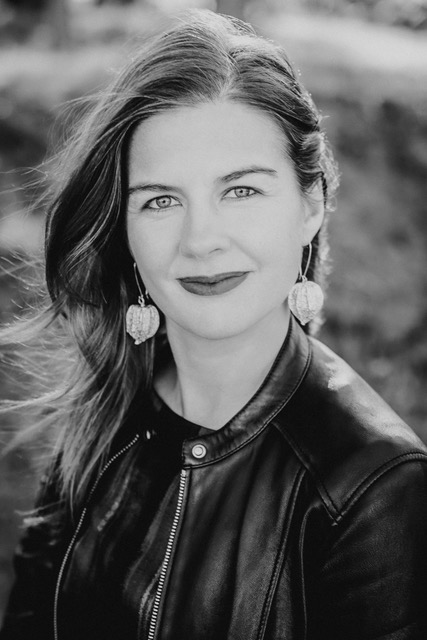 |
|
| (credit: Stephanie Ewnes Photography) | |
In 2019, Elizabeth Rush was invited to join the scientists and crew on an unprecedented expedition to Thwaites Glacier, a never-before-explored part of Antarctica. From that experience comes The Quickening: Creation and Community at the Ends of the Earth (Milkweed Editions; reviewed in this issue). Similar to Rising: Dispatches from the New American Shore (finalist for the Pulitzer Prize), The Quickening looks unflinchingly at the difficult truths of climate change and the complicated decision to become a parent at such a time. Rush lives in Rhode Island, and teaches creative nonfiction at Brown University.
For a book ostensibly about a scientific expedition, The Quickening takes an unusual structure and slant, incorporating a surprisingly high volume of dialogue. What made a four-act "play" the right form for this story, and why was it important for the "cast" to speak in their own voices?
It's a choice that I can trace to a single book. I don't know if you know Ilya Kaminksy's book Deaf Republic.
I love that book.
It's such an incredible book. It's a collection of poems about a community living through a repressive regime, and at the start, there's a cast of characters. For instance, you see something like "Sonya, pregnant, puppeteer." There was something about that structure that made each character feel like an autonomous, fully formed person, like I was being invited into this community.
I wanted to try that structure in this really different form. My book is not poetry, but I didn't want my shipmates to be experienced through the cipher of me as writer and documentarian; I wanted them to sprout from the page fully formed. So my narration is regularly interrupted by my shipmates speaking, and that's formatted on the page to look like a screenplay. They speak directly to the reader.
You mention feeling invited into community by Kaminsky's book. With all the big issues in this book--Antarctica, climate change, motherhood--it would be easy to miss part of the subtitle: "Creation and Community at the Ends of the Earth." But one of my favorite pieces of dialogue is when Gui says of life on the boat: "Every time I need help, I ask, and every day, people help." What do you think might change if our everyday world looked more like this?
As a mother to a young child and before that, being pregnant in the pandemic, birthing a child into a pandemic--one of the hardest parts has been learning to ask for help from my community. I pride myself on being independent. We've been taught it's a valuable characteristic, and as a woman you want to lean into that independence even more. And yet, something that I've experienced--on the boat but also through early motherhood--is that your community wants to help, they want to feel useful. When we don't ask for help, we deny people the possibility of feeling useful and needed. I get that it's hard to do, but it is central to the creation of a community that's interdependent and tight-knit and reliable.
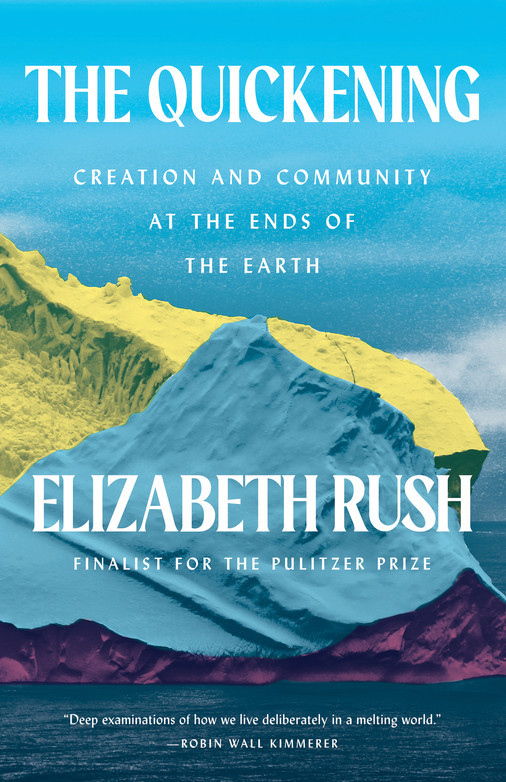 You write, "Some call this moment, and the many others that are piling up, the beginning of the end. Some suspect this is how the insurgency starts, with the rattling of glaciers." Would you call it that?
You write, "Some call this moment, and the many others that are piling up, the beginning of the end. Some suspect this is how the insurgency starts, with the rattling of glaciers." Would you call it that?
I wouldn't say that we're at the beginning of the end. If we take a more ample view of history, we understand that the world is always ending; worlds are always ending. The question is: How do we live through that and become stronger, more whole somehow, on the other side? I would love to think that this is the beginning of the insurgency as well, but I don't think that's a certitude. I think that's very much up to us.
In several places throughout the book, you engage our understanding of time and how our connectedness through time affects how we see the world. It seems like you were trying to pan out and show a longer sweep of history, a broader perspective. Why was this subtle thread an important one here?
Totally! It is so hard for us to think outside of human time. There have been all these psychological studies that conclude we can understand our parents and our grandparents, and we can consider our kids and our grandkids, but beyond those boundaries, it's very hard for humans to get a grasp on time.
So to think about the timeline of trees or glaciers--is that impossible?
I think we can try! I was on the boat with a lot of glaciologists, studying the movement of glaciers 10,000 or even 20,000 years ago, around the last glacial maximum. Or they're looking at sedimentary records around the same time, trying to figure out how Thwaites has acted since the end of the last Ice Age. They are fundamentally aware that their life is a really tiny blip in a much longer range. So I know it's humanly possible.
I remember asking chief scientist Rob Larder if Antarctica shapes us. I thought he was going to dismiss my questions as humanistic sorcery, but he said yes. The last 6,000 years of planetary history have been really stable. If you go beyond that, sea levels regularly rise and fall 5-6 feet per century. Which is what we're facing now, and it's throwing our world into chaos because we're not used to it. We're used to sea level variability being really low in comparison to the standard in geological time.
Your book Rising opens with a simple epigraph from Simone Weil: "Attention is prayer." How do books like The Quickening help us find that kind of reverent attention to the world around us?
In the environmental literature and humanities world, there's a big push for recognizing the animacy of nonhuman actors right now, and I think what The Quickening offers in terms of paying attention is that it is actually a laborious and time-consuming task. I think it sometimes appears cloyingly simple. Like, let's recognize the animacy of trees! But to do that, you actually have to pay attention over these longer time scales. I hope The Quickening is an invitation to think about attention to nature or nonhuman actors as something you foster in the place where your life takes root. It's too easy to think about going on this huge expedition and getting to see these sublime things or climb this mountain. At some level the book is saying it's way more important to hone that attention at home. It talks about the fallacy of only tuning in or turning oneself on in those heightened moments.
You wrestle with the decision to bring a child into this potentially collapsing world, but at one point you suggest having children might be "an act of radical faith that life will continue, despite all that assails it." How do you manage that fine balance between hope and the despair that can set in when we look too long at the facts of climate change?
Part of me thinks you do it because you don't have another choice. There's not an option. And isn't that true of everything that is really rewarding and hard. Everything that's worth it is at some fundamental level not easy. And you wouldn't do it any other way. It's a fallacy to assume that you can have hope without despair or hope without fear or hope without concern. Hope is a tool that propels you to make that world the way you want it to be. --Sara Beth West, freelance reviewer and librarian
Book Candy
Book Candy
Established in 2019, the Seoul Book Repository has a photogenic "tunnel"
and is South Korea's first municipal secondhand bookstore, Atlas Obscura noted.
---
CrimeReads explored "Cape Cod: the perfect location for a mystery."
---
Pop quiz: Merriam-Webster's "challenging words you should know: not a quiz for the pusillanimous."
---
Thomas McGuane has donated his papers to Montana State University Library.
Rediscover
Rediscover: Michela Murgia
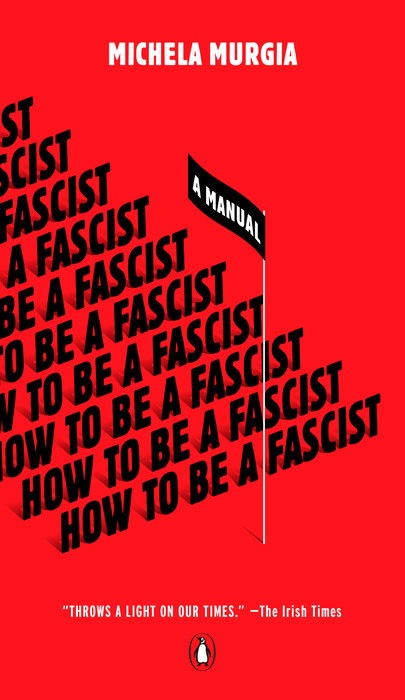 Italian novelist, intellectual, and civil rights campaigner Michela Murgia, who "was a voice for minorities and a lightning rod for political debate" while garnering respect even from a prime minister whose policies she opposed, died August 10 at age 51, the New York Times reported. Murgia burst onto the scene nearly two decades ago with her first novel about her experience working in a call center. She was an outspoken critic of the country's rightward shift "at a time when its left-wing parties appeared to have lost their voice, and a feminist and civil rights champion urging acceptance of nontraditional family configurations in a nation in which the governing parties have promoted a more conservative vision."
Italian novelist, intellectual, and civil rights campaigner Michela Murgia, who "was a voice for minorities and a lightning rod for political debate" while garnering respect even from a prime minister whose policies she opposed, died August 10 at age 51, the New York Times reported. Murgia burst onto the scene nearly two decades ago with her first novel about her experience working in a call center. She was an outspoken critic of the country's rightward shift "at a time when its left-wing parties appeared to have lost their voice, and a feminist and civil rights champion urging acceptance of nontraditional family configurations in a nation in which the governing parties have promoted a more conservative vision."
Winner of the Premio Campiello literary prize in 2010, Murgia was a playwright, essayist, and columnist, the Guardian reported. She made her literary debut in 2006 with the novel Il Mondo Deve Sapere (The World Must Know), a satire about exploitation in a telemarketing call center that was made into a play and later adapted into the 2008 film Tutta la Vita Davanti (Whole Life Ahead) by Paolo Virzì. Her best-known book, Accabadora (2009), about euthanasia and adoption, earned many awards.
Known for her campaigns for LGBTQ+ rights and euthanasia, Murgia publicly revealed a few months ago that she had been diagnosed with stage four kidney cancer and had decided to speak openly about her illness, continuing to write articles and appear at public debates. In July, she announced that she had married actor and director Lorenzo Terenzi "in articulo mortis," Latin for "at the point of death." The New York Times wrote that "under Italian law, her blood relatives would have inherited her property and been responsible for decisions about her unpublished work and her legacy. Although she was not in conflict with her family, marrying Mr. Terenzi ensured that her will would be observed, friends said."
In 2022, she wrote God Save the Queer, an essay in which she reflected on the possibility of being a feminist and a Christian: "I would like to understand, as a feminist, if the Christian faith is really in contradiction with our desire for an inclusive and non-patriarchal world, or if instead it can't even show itself as an ally. As a Christian, I trust that faith also needs a feminist and queer perspective."
Even some who opposed her views, including Prime Minister Giorgia Meloni, offered tributes, praising Murgia as "a woman who fought to defend her ideas, albeit notoriously different from mine, for which I have great respect." Murgia's final book, an ironic guide "to turning your 21st century democracy into a fascist paradise" titled How to Be a Fascist, was published in 2020 and is available from Penguin Books ($15).


